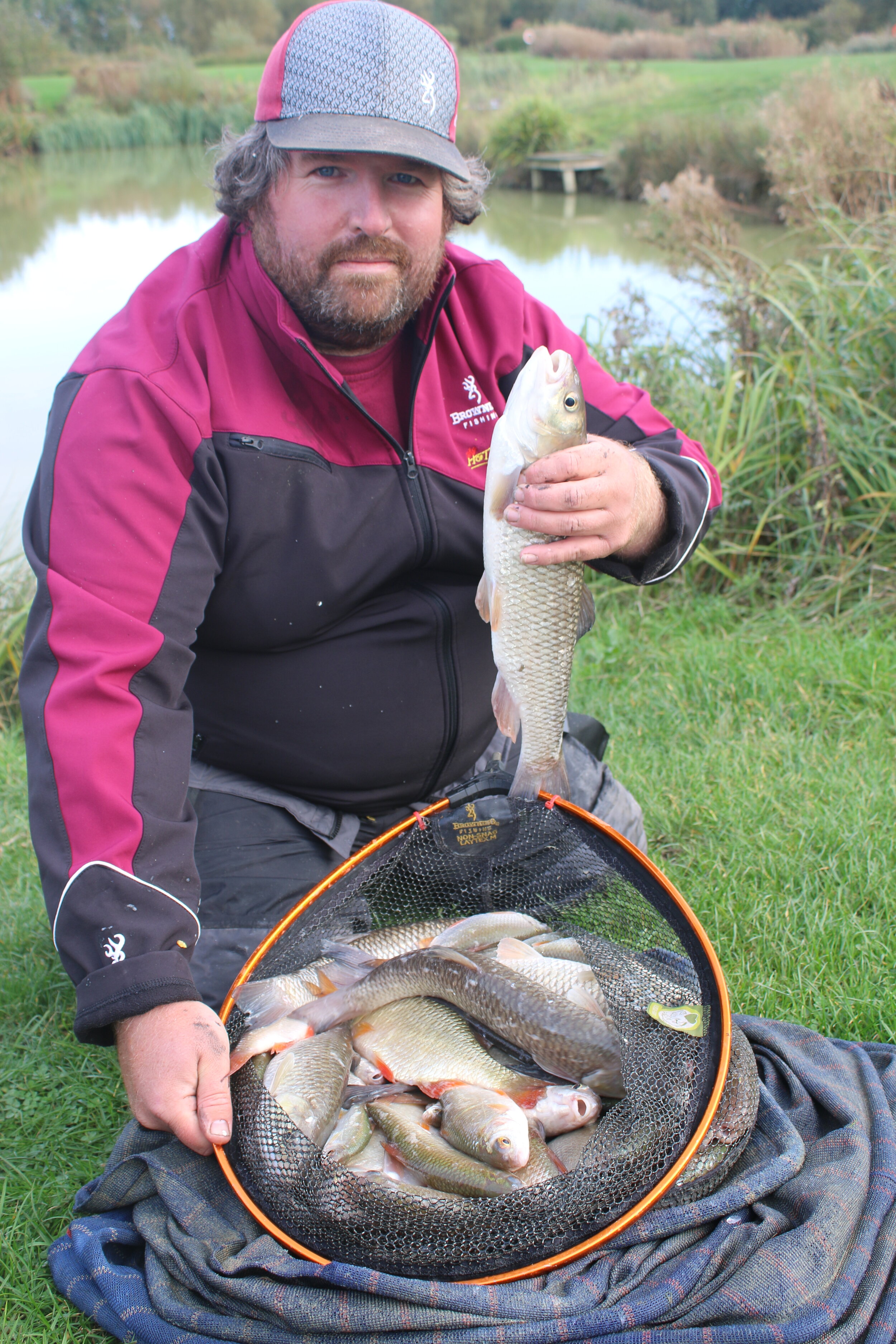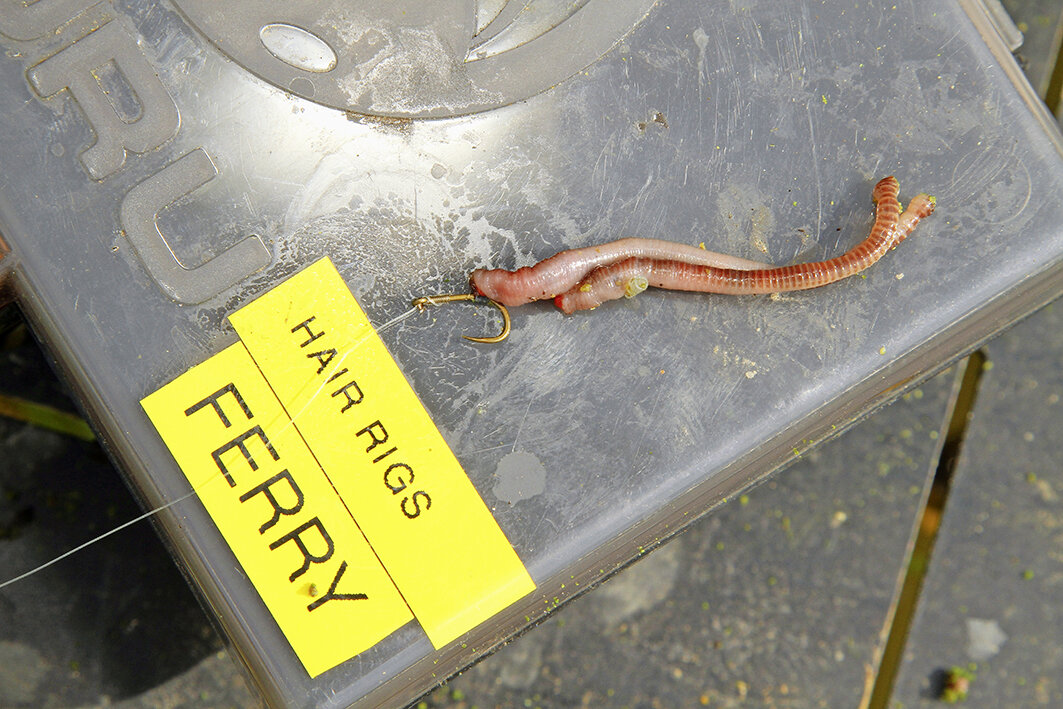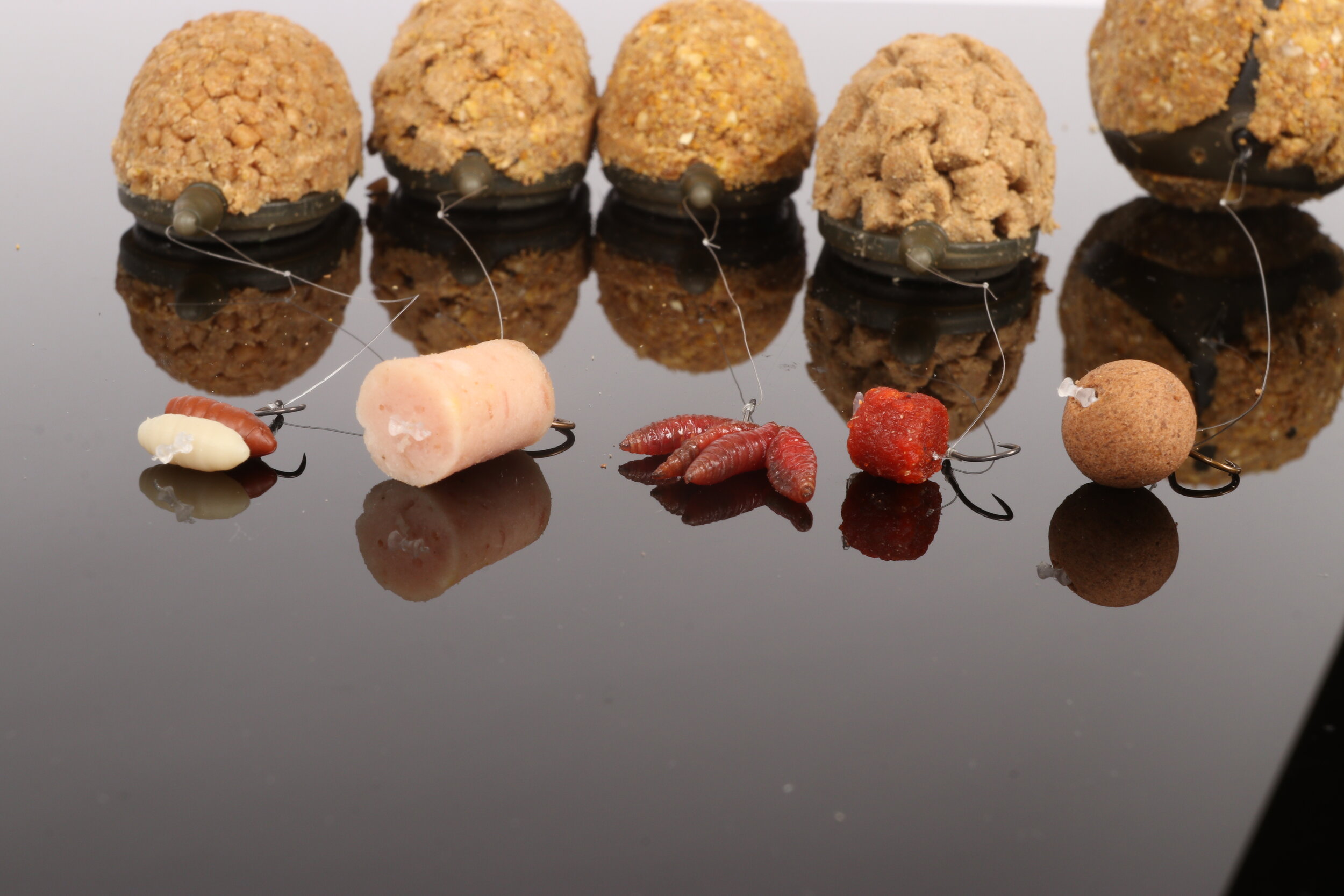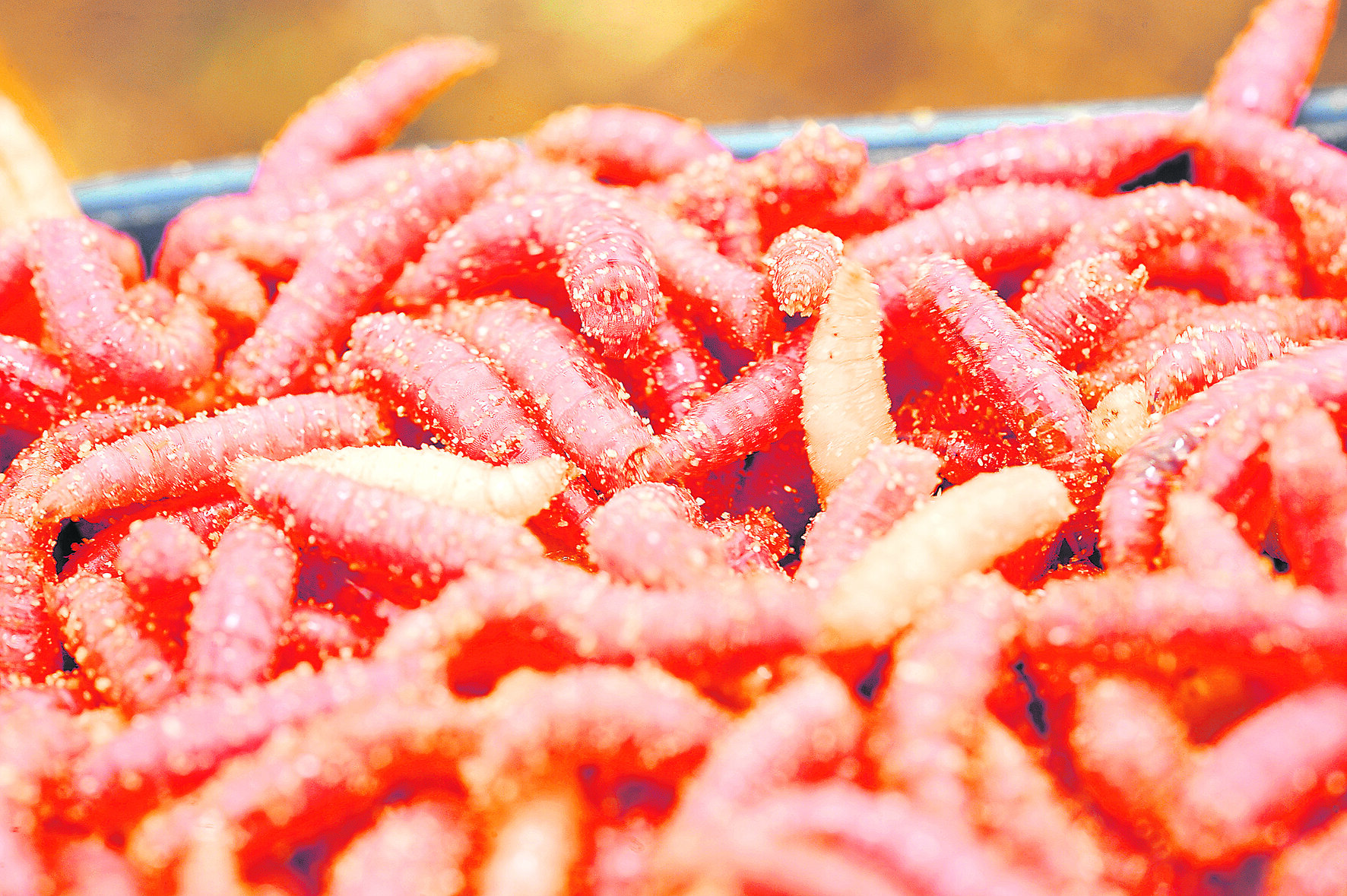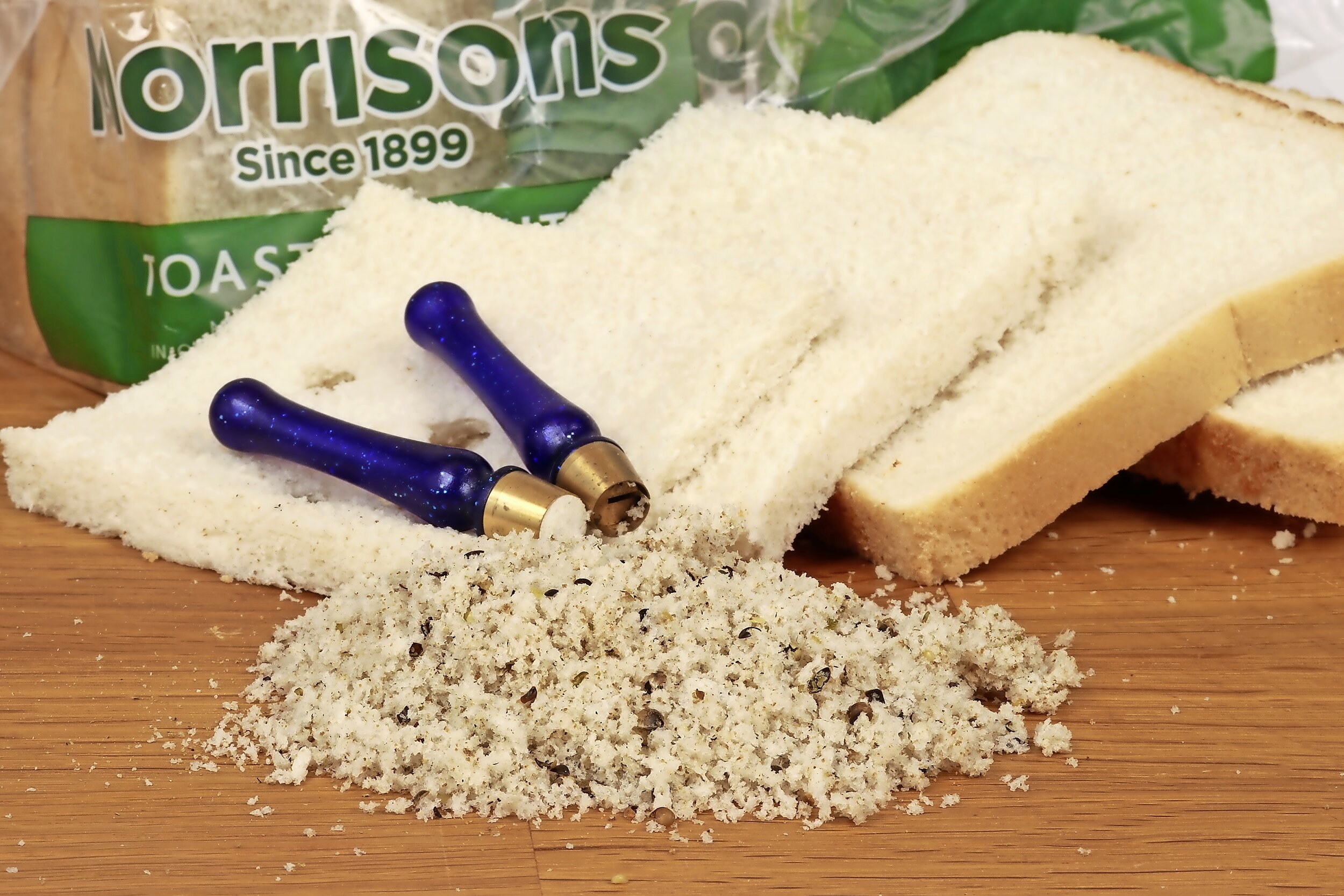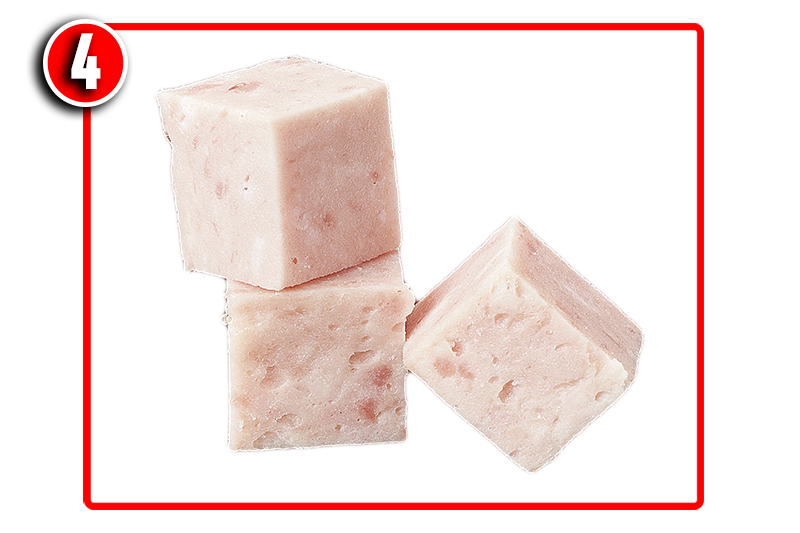How to make paste for carp fishing
Many anglers think that paste is for commercial carp fishing only when really it can be used in all types of carp fishing and is definitely a worthwhile tactic to look at next time you are on the bank. We've gone to paste expert Colin Spencer who will real how he has perfected this simple and extremely effective bait
No-shot rig
“One of the most frustrating elements of paste fishing is trying to work out what a bite is. The float will constantly bob around when there are carp around the hookbait, but you are looking for it to dip quickly.
“My rig has no shot down the line, with the weight of the paste cocking the float. A fairly slimline float works best, typically a 0.2g version threaded on to 0.17mm mainline straight through to a size 16 Guru Pellet Waggler hook.”
Vary your paste
“If I am getting plagued by small fish or I’m having to wait a while for bites I’ll stiffen some of the paste up by adding more groundbait.
“If the fish are coming thick and fast then I’ll do the opposite and add more water to a batch to make it slightly sloppier.”
Accurate feeding
“Feeding is just as important as the hookbait. On a prolific venue, don’t feed much or you’ll be dogged by foul-hookers and line bites. I just place a small amount of corn and pellet in a pole cup, place my paste hookbait on top and cup it all into my target zone.
“Then I’ll repeat this process after each fish.
“I’ll stop feeding altogether for a while if I have a run of foul hookers in order to force the fish into taking my hookbait.”
Make Colin's paste
Pour a whole bag of Dynamite Baits Green Swim Stim groundbait into a shallow, round bowl.
Add four pints of lake water to the groundbait.
Mix vigorously so the water is evenly distributed.
After 15 minutes the mix will have stiffened up – perfect.
Mould the paste around a size 16 Guru Pellet Waggler hook.
How to make the best carp method feeder mix
Method feeder fishing is in full-swing, but despite it being a fiendishly simple tactic, it can be more tricky to master than many imagine. Carp have become accustomed to finding bland feeder pellets dotted around a lake every single day, and those tip-slamming bites become less frequent.
So try these simple bait tips and I guarantee you will see your catches go through the roof.
STICK TO IT
Getting your pellets dampened just right is essential with the Method. The reason it works so well is that it presents a concentrated pile of feed with the hookbait dead-centre.
If the bait flies off the feeder in mid-cast, or as it sinks through the water column, you are reducing the effectiveness of the rig and spreading the fish out.
I still see anglers trying to keep their pellets as dry as possible. In theory this sounds good, as the bait will break down fast, but often it doesn’t hold together.
With modern ‘sticky’ pellets, although the bait holds together firmly, it starts to absorb water as soon as it is cast out and it is
this effect that ensures the feed breaks down quickly.
If the fishery insists that you use its own pellets there are a couple of things that you can do to make them bind together properly. Use a sprinkling of pellet bond, Horlicks, or PV1 to enhance their stickiness. Alternatively, mix a handful of the fishery’s micro pellets in with any larger baits. This is particularly good with 6mm feed, as the gaps between individual pellets are quite large and are filled in by the micros.
flying start
A large Method feeder deposits quite a lot of pellets in the swim, but it can take time to get the swim rocking simply because there isn’t enough feed out there. To overcome this I will start off by making 10 quick casts with the loaded feeder and no hooklength attached.
Give each cast a minute or two for the pellets to absorb water and loosen up before retrieving. You’ll often find that by the time you are halfway through baiting up, a few line bites will indicate that the carp are getting their heads down.
By not fishing straight away I also find that the carp tend to be more confident, and I will catch more when I do bait the hook.
FLAVOUR YOUR FEED
Making your feed stand out on venues where you have to use the fishery’s own pellets is an absolute must. Why would I want to use the same bait as everyone else when I can use something better?
Rather than just use a flavouring I like to add something that not only tastes good, but improves the quality of the bait. Fish sauce, used in oriental cooking, is a great pellet additive and only costs a couple of quid for a year’s supply.
Boilie food soaks are also ideal – just add a teaspoonful to the water before preparing your pellets and the goodness will be drawn right into the centre of the bait.
VARY YOUR HOOKBAIT
If ever you needed proof that changing your hookbait can make a big difference to your catches, try experimenting with the Method. A flurry of fish on one hookbait colour will often fade out, only to be revived by switching to something else.
This doesn’t just apply to carp – bream can be just as fussy when it comes to hookbaits.
Colour does seem to be the main attribute of the bait that makes a difference, and I am happy to use quite a range of different flavours. This stands to reason really, as the hookbait is just the ‘cherry on the cake’. The pellet feed attracts and holds the carp, while the coloured hookbait grabs their attention.
Wafters have become very popular in the last couple of years and very effective they can be too, not so much because the fish prefer to eat them, but because they make hooking fish more efficient. These semi-buoyant baits are easier for the carp to suck in, meaning the bait and the hook sail further back into their mouths, giving more and better hookholds on short hooklengths.
Of course, there are days when the carp will be prepared to eat everything you throw at them, but remember, even small carp will have seen a Method feeder approach almost all of their lives. Little wonder, then, that they have grown a bit cagey.
Mixing things up and trying to improve your baits, as well as ensuring they actually work as intended, can often make the difference between a reasonable day and a red-letter one.
Preparing pellets for the Method feeder can take a bit of practice before you get the correct consistency. Follow these steps and you’ll get it right every time.
Small pellets bind together the best, but they can be the least attractive to the carp. Start with 4mm pellets, but be prepared to add a few 6mm baits to give the carp something larger to feed on.
To make the fishery’s own pellets more attractive, start by adding a tablespoonful of fish sauce to two pints of water in a bait tub. You can buy this cheaply in supermarkets or delicatessens.
Soak your pellets in lake water for a few minutes, making sure they are completely covered. As a rule of thumb, soak 4mm pellets for four minutes and 6mm pellets for six minutes.
Drain the water off using a fine sieve, as here, then put the lid on the bait tub and allow the pellets to soften for a minimum of 20 minutes until they have a nice sticky consistency.
If the pellets aren’t binding together very well, give them a light dusting with pellet binder or PV1 binder. Mix this in and add more if need be.
Always keep your Method mould clean, and compress the pellets firmly on to the feeder. If the pellets stick to the mould, lightly coat it in fish or cooking oil.
Fishing with meat tips
With fishing with meat being as popular as it is especially on rivers and commercials we thought that we'd let bait expert Dr. Paul Garner walk you through the different things you can do to give your meat an added edge when you are on the bank fishing.
Luncheon Meat rules
Bacon Grill and chopped pork and ham were among the first baits I ever used and both still have a constant place in my emergency bait supplies stashed in the car, thanks to their long shelf life and adaptability.
Bacon Grill remains one of my favourite brands, being quite firm and sinking well. It can be easily chopped or punched.
Do check the ingredients list on tins of luncheon meat, though, as some contain chicken instead of pork. This makes them much softer, and some brands are prone to float. All the different versions are worth experimenting with – you’ll soon find your favourite.
Hot Dogs for pole work
A cheap and under-rated meat bait. Most hot dogs contain more chicken than pork, a very different proposition to luncheon meat.
Their soft texture makes them ideal for short-range work on pole or leger. They are quite buoyant too, useful for fishing on the drop or when a wafter-style bait is required to turn finicky bites into something more positive.
You can simply slice hot dog sausages into chunks for larger fish, a useful tactic if you are freelining for river chub.
Most of the time, though, it’s a 6mm or 8mm punched bait that does the business. Use a fine baiting needle to carefully hair-rig these soft baits. They are also ideal for side-hooking on the float. Why not use them as a very visual hookbait when floatfishing pellets for barbel and chub?
Fish Bites are back!
Back in the day I caught a lot of fish on Dynamite Baits’ Meaty Fish Bites – small chunks of meat heavily glugged in fish oil to give them an extra boost that carp and barbel couldn’t resist. Fortunately, they have recently been re-released, and are now available in different sizes. As a ready-to-go hookbait, they are well worth having in your bait bag.
Salami
Among my favourite baits in the last few years are the various salamis and pre-packaged snack meats that have become really popular. Peperami is probably the best known of these products, but there are lots of other different varieties available, many of which are useful baits.
Straight from the packet, Peperami is just the right size as a carp bait – simply cut it into chunks and hair-rig it. This tough bait will easily last all night and is loved by carp and barbel. For smaller species I use a bait punch to produce my hookbaits. These can range from 4mm upwards, making them ideal for tench, bream and crucians. These small baits are also useful for larger species when they are playing hard to get.
why not fry your meat?
The high fat content of many tinned meats can make using them in hot weather very tricky, especially if you need to cast them any kind of distance. Their soft texture is ideal for pole fishing, where the hookbait can be carefully lowered in, but use the same bait on a leger rig and the cast will often dislodge the hookbait.
One simple tactic to prevent the hookbait being lost is to push a small piece of dead grass under the bend of the hook before pulling it into the bait. This works surprisingly well, but can impede the hook on the strike.
More effective is to toughen up the meat by lightly frying it, so that it can be side-hooked or hair-rigged. Frying draws a lot of the fat out of the meat and gives it a tough skin. Start by cutting the meat into cubes, then warm up a large frying pan and add the cubes of meat. Keep them moving around the pan and fry them for about two minutes.
I will often add some garlic granules or chilli powder to give the bait an extra kick. Let the cooked cubes cool down on a sheet of paper towel and they are ready to use.
Land the biggest F1s with this amazing paste
If you thought paste was a bait reserved for catching big carp then you’d be missing a big trick – that’s the verdict of match ace Steve Gregory who is famed for his antics with the stuff across a wide variety of commercial fisheries across the UK.
Paste still catches ‘lumps’, but as F1s become more common in our waters, Steve has adapted his approach to catch the lion’s share of a finicky species more associated with smaller hookbaits.
He’s perfected paste fishing for F1s so much that he can keep pace with anglers playing the numbers game fishing pellets and maggots. It’s all to do with the stamp of fish that paste produces on waters holding fish ranging from ounces to 2lb.
“Fish pellets and you’ll catch, but I’ve found the size can vary greatly,” Middy-backed Steve explained.
“My paste sorts out the bigger F1s and it’s rare to get one under 1lb. There are lots of myths surrounding fishing paste and I think that can put anglers off using it. They shouldn’t be worried because once you master a few simple basics it’s a very easy method to fish.”
To demonstrate, the former British match record-holder invited us to Falcon Lake at Westwood Lakes near Boston, home to thousands of F1s of all sizes to show paste’s power.
Paste consistency
“Groundbait pastes are a waste of time because they dissolve,” Steve said bluntly. “That defeats the point because I want my hookbait to stay on for as long as it takes to get a bite. People think that I have a magic paste mix, but it’s just my original Miracle Paste that I’ve been using for years. However, I mix it a few days in advance because this gives me the consistency that I want.”
“It has to be soft enough to strike through, but stringy enough to stay on when fish are knocking into the line or mouthing the bait. I’ll prepare plenty of paste because, on places like Falcon Lake, you could be getting hundreds of bites and so getting through a fair bit. Two bags makes enough for a hectic session.”
Hookbait size
“It’s important to match your hookbait to the size of fish. Because F1s are the target, there’s no place for massive lumps the size of your thumb!” Steve said.
“I don’t use little pea-sized bits either. Typically, the bait is around the size of a £1 coin. That’s large enough to catch bigger F1s.”
Fishing short
“I’ll fish a top kit if I can to save time on waters where every second counts,” Steve said.
“Having to unship a section of pole each time can lose you 15 minutes of fishing time. That can work out at over 20 fish you miss out on catching on days when the fishing it good. Fishing short puts you on top of the near shelf on a flat bottom, which is a must for paste fishing.”
Spotting a bite
“Don’t be tempted into striking when the float goes under – it’ll do all sorts of things as fish knock into the line or mouth the bait,” he advised.
“You’re looking for a specific indication on the float. This will be a sharp, positive ‘dig’ on the float as a fish gets hold of the paste properly. Even then you will foul-hook a lot of fish because of the number in the swim. By fishing relatively light hollow elastic, I can get these foul-hookers in. If you aren’t connecting with bites, hold the float tight to the line and you’ll see it fly under!”
Big hooks still rule
“Fishing paste on a size 14 hook is a waste of time because you won’t convert bites into hooked fish. You still need to fish a big ‘anchor’ and for me that’s a size 12 Middy 83-13 pattern. That’s plenty big enough to hold the paste in place and still strike through and get a good hook hold,” he explained.
“Lines are 0.14mm Hi-Viz fished straight through with that light elastic being Middy’s 8-10 hollow grade.
“Finally we should talk about floats and I go big on this front too with a 0.7g handmade model that’s got a relatively slim body. I’ve seen blokes fishing paste with no shot on the rig, instead relying on the paste to cock the float. That’s nonsense and all it does is see any tow or wind on the lake put pressure on the hook and ultimately rip the paste off. I also leave the whole bristle showing to read bites better.”
Top margin baits you can use right now!
With spring now here Daiwa's Will Raison offers some timely advice for the best margin baits to be using right now. Here are his top baits to use when fishing for big carp down the margins.
Sweetcorn
Forget using a single grain of corn in the margins – two pieces will get you more bites and bigger fish, working on the principle that a carp will spot two bits of yellow corn far quicker than just the one, especially when the bottom is being churned up by feeding fish. Corn is also a heavy bait that won’t be washed about and is hard for little fish to rip off the hook.
Dead Red Maggots
Without a doubt the number one margin bait! I cram up to seven or eight dead reds on to the hook to create a massive hookbait that no carp can miss or refuse.
Deads are very soft and still look like their live counterparts to the fish, but don’t wriggle. When fishing over a large helping of dead reds, carp will move in and hoover up the lot, including the hookbait. They’re a very light bait that are easy for the fish to suck in.
To make dead red maggots I simply clean the sawdust off a few pints and put them in a plastic bag, remove all the air and seal them tightly. The maggots then go into the freezer for three days to ensure they’re dead – I have frozen them for one day before, only to see them come back to life!
Worms
These are venue-specific baits in my experience and tend to work on waters that see a lot of chopped worm and caster used by anglers– the carp get a real taste for them.
They’re also great if there are a lot of roach and rudd in the peg that are smashing maggots to bits. I’ll fish one or perhaps two for a big bait. They’re also worth having in reserve as a change bait when using maggots and groundbait, as the bites can be very savage.
Luncheon Meat
Meat can be very cyclical, in that it works over any other bait for spells during the spring and autumn. However, in July and August I would still have some 10mm cubes with me to slip on to the hook as a change bait.
Dr Paul Garner's 10-minute make | Grilled meat
In hot weather luncheon meat can become very soft as the fat in it melts. To make a much tougher bait, try frying the meat first. This cooks out the fat and puts a tough skin around the bait.
Cut a tin of luncheon meat into three-quarter-inch slices.
Heat up two teaspoonfuls of cooking oil in a frying pan.
Add a teaspoonful of garlic powder to the pan.
Fry the meat for two to three minutes on each side.
Break the meat into chunks to give you the perfect bait size.
Dr Paul Garner's 10-minute make | Preparing chickpeas
Chickpeas make a great pre-baiting ingredient and they’re not expensive. You need to prepare them properly though. Here’s how I do mine…
Cover a pint of dry chickpeas with two pints of water in a bait tub.
Add about a teaspoonful of red dye. This will darken the bait down and make it blend in better.
Add a teaspoonful of Scopex No.1 flavour and half a teaspoonful of intense sweetener or Betalin sweetener.
Leave in the fridge overnight so that the chickpeas will be completely rehydrated. The flavour and colour will be drawn right into the bait.
Bargain basement baits
The bait we use can be a big outlay for all of us, especially when faced with venues full of hungry carp, but do you really have to spend a fortune on expensive offerings, or are cheaper alternatives just as good? This week I take a look at some of the bargain basement baits that are out there.
Cut the waste
I am just as guilty as the next man of taking far too much bait with me, especially when faced with a venue that I am unfamiliar with. I just don’t want to turn up and find that people are bagging-up on a bait that I haven’t got in my bag.
To combat this problem, check out the venue’s website or maybe give them a ring before your trip. Most of the time you can get some useful and up-to-date information on what is working.
Even if you have sparse information about the venue, other than the species you’re after and the tactics you’re going to use, you can still use this to cut down on bait expenses. I find it better to put ‘all my eggs in one basket’ and go with a clear plan of how I am going to fish with just one or two baits, than take too many.
Rarely do I find that I have too little of a certain bait with me, so think carefully about how much you need, or use baits that can be saved until your next trip if they go unused. This can save a lot of waste and cut your costs too.
Here are some of the cheapest baits around, but ones that will still catch an awful lot of fish...
Often overlooked, bread is a fantastic commercial bait, and one that will catch a range of different species. At this time of the year try punching a slice of bread and pinching the 8mm disk around the shank of the hook. Bread has the obvious advantage of being highly visible, and also very light and fluffy, making it ideal on days when the fish are not feeding confidently.
Also, try fishing bread over groundbait, as the light texture of the hookbait resembles the fine particles of feed. To bulk out your groundbait, mix it as normal and then add an equal amount of finely-liquidised bread to achieve a rich feed that will break down quickly and form a carpet of bait.
We really overlook cheese baits in the UK, but go over to the continent and cheese-flavoured baits are among the best-sellers. Some of the pre-packaged ‘snack’ cheeses have a great consistency and strong flavour that singles them out as top hookbait choices. Best of all, they are cheap.
If you have a meat cutter then this will make short work of rubbery blocks of cheese, turning them into the perfect size for both the hook and for feed. Cheese really is a brilliant carp bait, and if you punch smaller pieces you will be surprised at what other fish species you will catch too!
Meat can be quite an expensive bait, but by shopping around you can find some real bargains, and because it is rather filling, most of the time you will only need a relatively small amount.
Garlic sausage is one of my favourite meat baits, as it has the perfect soft texture, but stays on the hair well. You can find it on the deli counter of your local supermarket. The strong aroma is also a noted carp and bream attractor, and in recent seasons small pieces of meat have caught me a wide range of different species.
Cut the sausage into 10mm thick slices and then use an 8mm meat punch to produce hookbaits that can easily be hair-rigged. Once I have punched out as many baits as possible I break up the remnants and use this as my loosefeed.
I like to use a soft paste, which is ideal for fishing either on the pole or on a long float rod down the edge. A more selective bait than my other choices, paste often sorts out the bigger carp and will also pick up bream and tench. Buy bulk bags of paste, as you only need to mix up as much as you need and the rest will keep for future trips. Go for a fishmeal-based bait at this time of the year.
You can make paste out of your favourite groundbait too. Just mix it quite wet and it will bind together well enough to be carefully swung out for margin fishing. If you want a tougher paste then instead of using water, mix the dry powder with an egg as this will bind it together much more firmly.
Dr Paul Garner's potato hookbaits
I suppose you could say that potato hookbaits really are as cheap as chips! While not suitable as feed, potato can easily be cut into slices and punched to make a tough hookbait. Better still, it takes on colours and flavourings readily, making it a very low-cost, easy-to-use alternative to other hookbaits.
Cut a potato into 10mm thick slices using a sharp knife. There is no need to remove the skin.
Use a bait punch to produce your plain hookbaits. Punches of 10mm and above work best with this quite tough bait.
Add a teaspoonful of Strawberry flavouring and half a teaspoonful of red dye, and shake well so that the baits are evenly covered.
After a few minutes the potato will have absorbed the colour and flavour. For best results, leave overnight in the fridge.
Potato baits are easy to hair-rig and are long-lasting, making them ideal for use with the Method feeder.
Prepare your pellets with Tommy Pickering
Pellets are without doubt the most effective bait on commercials at this time of the year, but a lot of them float initially when they come out of the bag. They may only stay on the surface for 10 seconds before dropping to the deck, but in even the slightest breeze this will lead to your bait drifting out of the swim, and sending fish with it. Take a look at this simple trick to make every single pellet sink the second it hits the water.
Take a handful of 4mm or 6mm pellets and place them in a bait box full of water. You will instantly notice that a proportion of them float. Once you have done this, pour the water and wet pellets away, wipe the box dry and add the rest of the bag of pellets to the tub.
I used to add sunflower oil to my pellets but now use a product that’s even more effective. To every pint of bait I use I add a capful of Sonubaits Clear Pellet Oil. It comes in three flavours – F1, Krill and Scopex – and all three release plenty of attractive scent into the water.
Place the lid back on the bait tub containing the pellets and shake the contents around vigorously for approximately 10 seconds. This will make sure that the oil spreads evenly, and that every single pellet gets a good coating.
Take the lid off and the pellets are ready for use straight away. The key difference to adding water is that the oil will not make your pellets swell and if you don’t use them all that session, you can take them home and they won’t go mouldy.
Six easy steps for using corn
There are few cheaper and more effective baits for commercial fishery carp at this time of year than sweetcorn. A large tin from the supermarket will set you back less than a pound, but it can provide enough bait to last the best part of a session. Corn is highly effective for a number of reasons, and high on that list is its bright colour and softness, especially when compared to a 6mm pellet or a cube of meat.
The colour makes corn stand out when fished on its own or over a bed of another feed, while its softness is much loved by all fish. It’s also not particularly filling, as a grain of corn boasts a high water content so carp can trough away for hours without getting full. It’s also brilliant for other species, with bream, tench and even quality roach all loving the yellow stuff!
Try sweetcorn on different colours
In its natural form, corn is bright yellow, and that’s perhaps the main reason for its effectiveness. Even in coloured water, fish can easily pick out a grain, and if the lake is slightly clear, this ‘high-viz’ quality comes even more to the fore. However, you can buy corn in different colours and flavours, and on some waters red corn will outfish yellow. If you’re not sure which colour to use, arm yourself with a variety and keep changing on every cast until you catch – even green corn can have its day!
Big hooks
Compared to a maggot or a pellet, corn is a big bait, so you need to match the size of the hook accordingly. On the strike, the hook will pull through a soft piece of corn but you’ll need to be able to mount the bait properly so it stays on during the cast. Pick a hook with a wide gape as this will allow the bait to sit comfortably on the bend, while leaving a decent amount of the hookpoint on show. This will aid hooking when the float goes under. In terms of hook size, a 14 or 16 will be just about perfect.
Choose the right floats
Corn is quite a heavy bait, so this means you have to think big when it comes to floats, especially when fishing in open water. If your float is too light then the presentation will be unbalanced, and the fish will sense this. On the pole, pick a float with quite a big body, such as a rugby ball or diamond shaped one of 0.5g to 0.7g, dependent on the depth. When fishing the margins this can be smaller, but certainly no finer than a 4x12 pattern. Shot this with a bulk and one dropper shot and set the rig so that the corn is just resting on the bottom.
Combine it with other baits
Fished on its own, corn is deadly, but it can be improved by feeding it with other baits. Hemp is brilliant when fed to create a bed on the bottom, over which corn hookbaits are fished to really stand out. Cubed 6mm meat is another winner at this time of year, mixed 50/50 with corn as feed. You can also pop a few grains into chopped worm and caster feed and this will give you the option of changing from a worm hookbait to a piece of corn if small fish are a problem.
Hooking Corn
There is a right way to hook corn, and although you can simply nick the hook through the side, it will eventually work loose and be hanging on by a thread. The best way to mount a grain of corn is to pierce it through the rounded end and work the hook down the grain so it comes out of the flattened bottom end. This ensures that all of the shank and most of the bend is inside the grain, leaving just the hookpoint on show. Using double corn also adopts the same principle.
Give it a go in shallow water
Should you be faced with fishing the far side of a snake lake or a shallow margin, corn can be transformed into a superb shallow-water feed. All it needs is a food blender to whizz the corn about for a few seconds to chop it into smaller pieces. When fed, it’ll create a lingering cloud, while the larger pieces will sink that bit slower. You can even go the whole hog and blend the corn into a sloppy soup that’ll put a bigger cloud into the swim. This works particularly well if the fish are feeding off the bottom.
Dr Paul Garner's 10 minute make | Preparing micro pellets
Micro pellets cannot be prepared in the same way as pellets of a larger diameter, simply by soaking or pumping – try to do that and they will quickly turn to a mush.
Instead, you have to add water a little at a time, allowing time for the micros to absorb moisture but never become saturated. You can add liquid flavouring to the mixing water (right) and for an extra ‘kick’ try a teaspoonful of rock salt sprinkled over the prepared pellets.
Add a teaspoonful of Cappuccino flavouring to a pint of lake water and mix well.
Slowly add some of the water to the micro pellets in a shallow mixing bowl. The pellets should soak up the water immediately.
When the pellets start to become tacky, leave them for five minutes so they are able to start absorbing the water.
Carefully add a little more water until the pellets are quite tacky but are still absorbing water.
Sprinkle a teaspoonful of rock salt over the pellets to give them an extra boost.
This is what the finished setup looks like!






